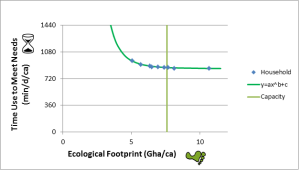
The graph above shows the time use and resource use of each decile of household income (although the highest two deciles are combined as the highest pentile). The lowest consuming decile, at around 960 minutes per day per capita, comes from the poorest people in Canada. It is not realistic to expect that all of their needs are met, and yet they have approximately 1/3 of their time available for meeting needs, and they don’t use it for that for some reason. I believe that this reason is that there are obstructions within society that prevent individuals, families, or community from being able to meet their needs effectively, and people will generally rather have unmet needs than to work ineffectively against these obstructions. Examples may be sexism, racism, classism, alcoholism, and so on.
Addressing these obstructions is beyond the capacity and role of engineers. Understanding how these obstruction prevent the Actualized Quality of Life reaching the Potential Quality of Life is entirely within the capacity and role of engineers, so it behooves us to do so.
I believe that people who encounter obstructions will find them stressful. I believe that people who find the obstructions unsurmountable will develop Chronic Stress. This is something that can be measured, and it has a relatively simple recipe to create. By deconstructing the recipe, I believe it is possible to identify which needs are not being met effectively, and which ones are, within any individuals within the community.
So, with a time-use study, a resource-use study, and some form of cause-of-stress study, we can find the time used by those that have each specific need met, and the time used by those who do not, to come up with a measure of both the Potential Quality of Life (the time available for activities other than those required to meet your needs) and the Actualized Quality of Life (the time available for activities other than those required to meet your needs, as if all of your needs were met). Ultimately, the intent of Sustainability Engineering is to ensure that the change in Actualized Quality of Life / cost to community is maximized.
The steps required to do this are:
Find the time spent within the community for each need:
For those individuals who have the need met = A
For those individuals who have the need unmet =B
Effectiveness E = ∑A/[∑A+∑B], all values summed across each need, for the whole population.
Potential Quality of Life PQoL = 1440 min/ca/d –[∑A+∑B]
Actualized Quality of Life AQoL = 1440 min/ca/d –[∑A+∑B]/E
= 1440 min/ca/d-(∑A+∑B)2/∑A
= 1440 min/ca/d-(∑A+2∑B+∑B2/∑A)
We see from this that a slight change in the time required to meet needs for those individuals who do not have those needs met currently will make the most significant improvement in the overall AQoL. In fact, taking the derivative produces
dAQoL = -{d∑A +2d∑B+2∑Bd∑B/∑A-∑B2/∑A2 d∑A}
= {1+∑B/∑A} {d∑A [1 -∑B/∑A] + 2d∑B}
To have a largest change in the AQoL, dAQoL should be at 0.
This requires that {d∑A [1 -∑B/∑A] + 2d∑B} = 0,
which means that [1 + 2d∑B/ d∑A] = ∑B/∑A
Note, this doesn’t include cost, so this won’t be the final answer, but it should be a good first estimate.